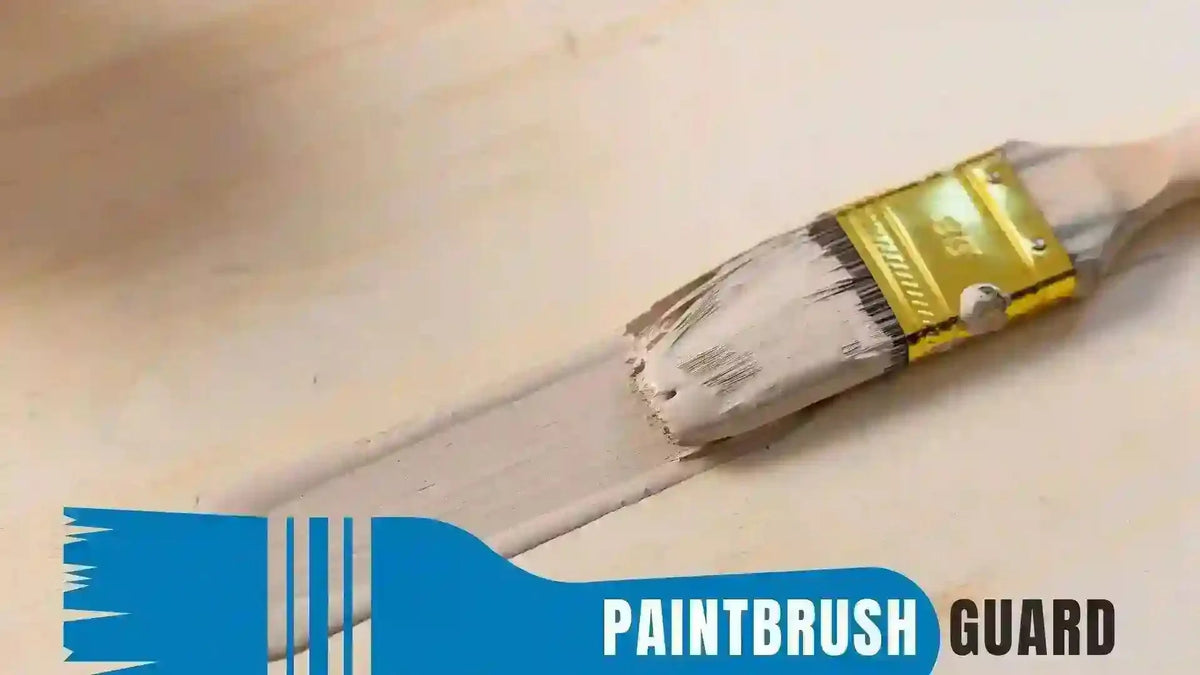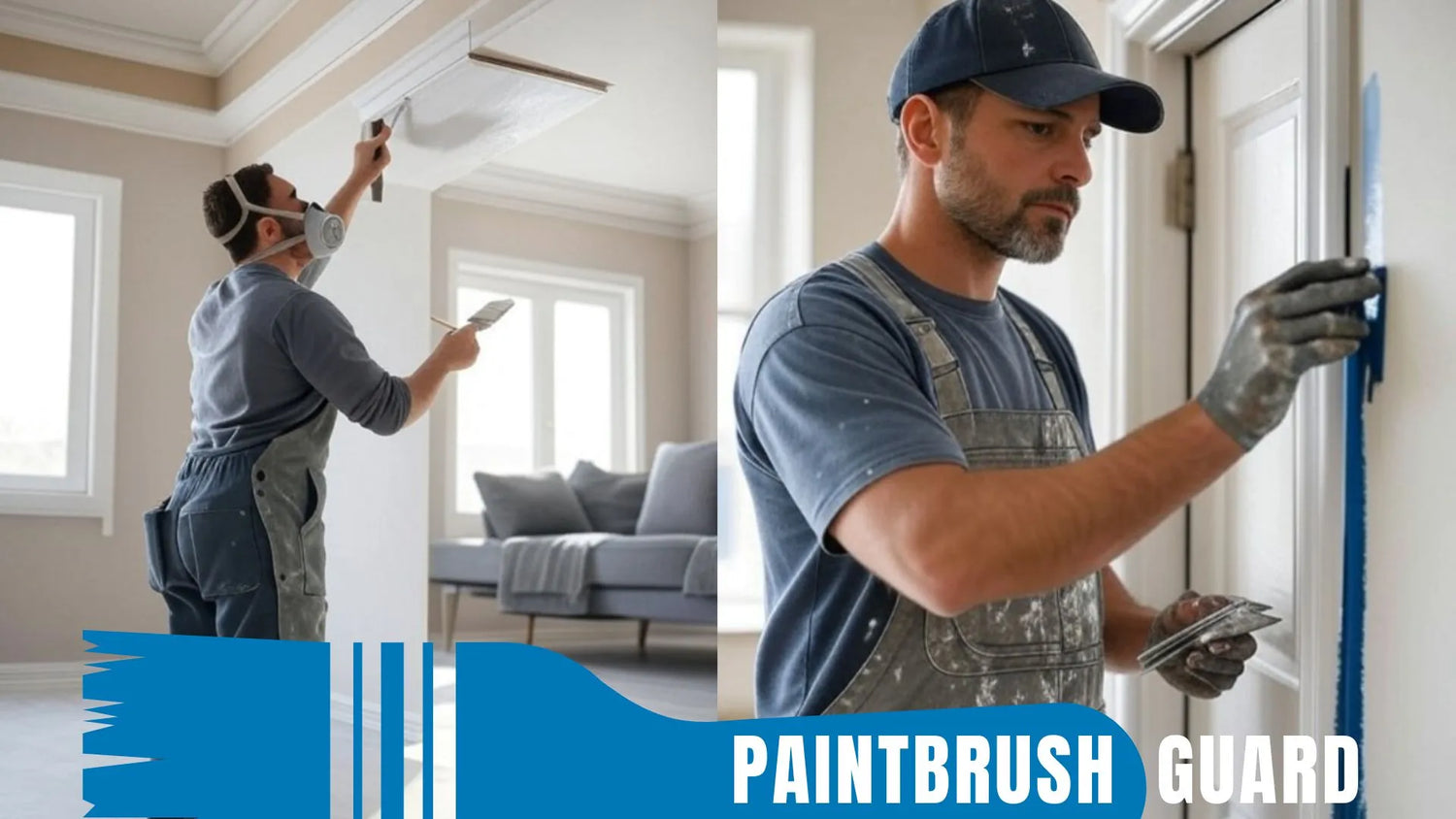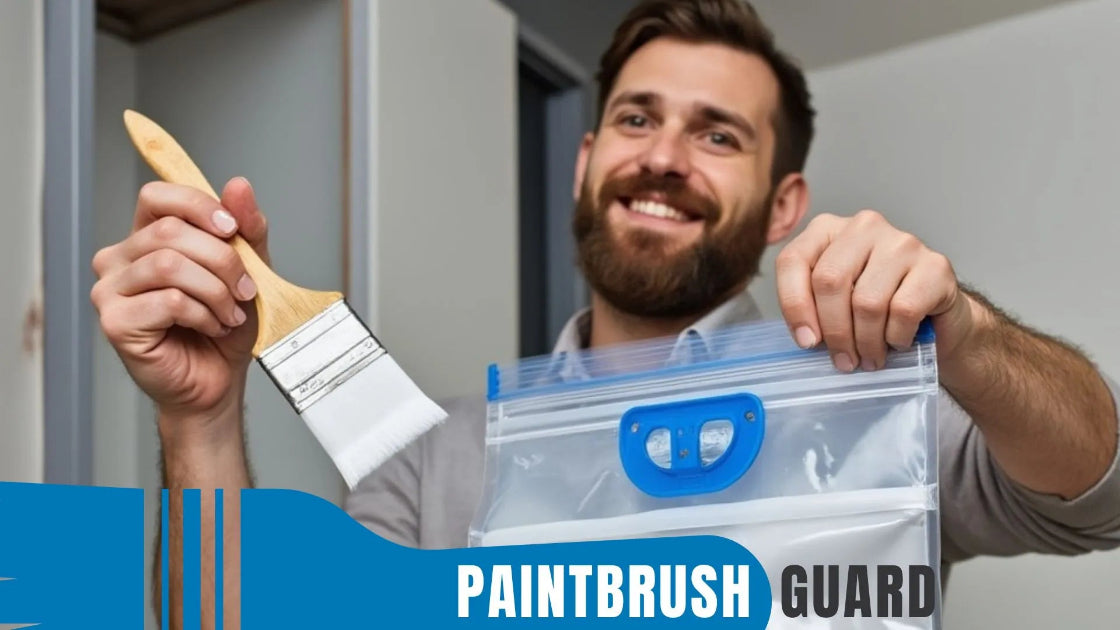
Paintbrush Lifespan and how to Make Your Brushes Last
|
Time to read 15 min
|
Time to read 15 min
This ultimate guide answers the top 20 questions about paintbrush longevity, offering practical advice to make your brushes last through multiple projects, from a small 12x12 room to a sprawling 1,500-square-foot exterior.
Every painter, whether a seasoned pro or a weekend DIYer, knows the value of a reliable paintbrush. It’s the tool that brings your vision to life, stroke by stroke, transforming a blank wall into a masterpiece.
But without proper care, even the best brushes can wear out quickly, leading to costly replacements and unnecessary waste. Paintbrush vacuum tools has become a game-changer, helping painters extend the life of their brushes while embracing eco-friendly practices.
With these tips, you’ll save time, money, and resources, ensuring your brushes remain your trusted companions for years of sustainable painting.
With no cleanup required after a painting session, you can take a short break mid-project or wrap up your painting for the day, your brush stays ready without the need to clean.
To make a paintbrush last longer, adopt a consistent care routine that protects its bristles and structure.
Start by dipping the brush only halfway into the paint, avoiding buildup in the ferrule, and wipe excess paint on a cloth during use, especially for a 12x12 room project (4 - 6 hours).
Clean immediately after each session, rinse latex paint with warm water and dish soap, or use mineral spirits for oil-based paint, taking 10 - 15 minutes to ensure no residue remains.
Condition the bristles every few uses with a lanolin-based conditioner to maintain flexibility, adding 5 minutes, and store flat in a cool, dry place, wrapped in cardboard to preserve shape.
Paintbrush Guard enhances this by keeping bristles wet during breaks, saving 15 - 30 minutes per session and preventing hardening.
These steps can extend your brush’s life to 50 - 100 hours, reducing replacements and waste, ensuring it’s ready for your next project.
A good paintbrush, with proper care, should last 50–100 hours of use, enough for several projects depending on its quality.
High-end brushes, like those from Purdy or Wooster, can endure two to three 1,500-square-foot house interiors (20 - 40 hours each), potentially lasting 3 - 5 years with regular maintenance.
A 2023 Paint Quality Institute study found that well-maintained brushes last up to 25% longer, pushing their lifespan toward the higher end of that range.
This sustainable approach minimizes replacements, reducing environmental impact, as new brushes often end up in landfills. With diligent care, your good brush can be a long-term partner, delivering smooth finishes for years.
This guide tackles the top 20 questions about storing paintbrushes, from quick breaks to long-term care, and even challenges like humid coastal areas.
Paintbrush Guard extends paintbrush lifespan by preventing paint from drying on the bristles, reducing the wear caused by harsh cleaning.
Its vacuum-seal technology creates an airtight environment, keeping bristles wet for days and halting the drying process that can harden paint in just 1 - 2 hours.
For a 12x12 room project with 2 - 4 hours between coats, this saves 15 - 30 minutes per break, cutting down on water or solvent use, a sustainable painting practice.
By avoiding the need for aggressive scrubbing, Paintbrush Guard preserves bristle integrity, extending life by up to 25%, per a 2023 study.
This means a brush that might last 50 hours could reach 62 - 75 hours, enough for an extra project. It also reduces the need for replacements, minimizing waste and supporting eco-friendly painting.
Paintbrush Guard ensures your brush stays soft and functional, ready for every stroke, project after project.
Replace your paintbrush when it can no longer deliver a smooth, precise finish due to irreparable wear, typically after 50–100 hours of use for a high-quality brush.
If the bristles are frayed, splayed, or falling out, or if the ferrule is loose, causing wobbly strokes, it’s time for a new one - especially noticeable during precision tasks like cutting in for a 12x12 room (30 - 45 minutes per coat).
Recycle the old brush if possible, minimizing environmental impact, and invest in a new one to ensure your next project, a detailed trim job, perhaps achieves the professional quality you aim for.
Discover how house paint colors influence mood & get expert tips on choosing the best colors for every room to create a vibrant, harmonious home environment.
You’ll know your paintbrush is worn out when it shows signs that compromise its performance, affecting the quality of your work.
Look for frayed or splayed bristles that leave streaks, bristles falling out during use, or a loose ferrule causing inconsistent strokes, all of which can ruin clean lines during a 12x12 room project (4 -6 hours). If the brush no longer holds its shape after cleaning, it’s worn out.
Replacing a worn-out brush ensures your projects maintain a professional finish, while recycling the old one supports eco-friendly practices, keeping your painting routine sustainable.
Yes, you can extend the life of a cheap paintbrush, though it won’t last as long as a high-quality one. Cheap brushes, often costing a few dollars, typically endure 10 - 20 hours, but careful maintenance can stretch this to 20 - 40 hours.
Dip only halfway into the paint to avoid ferrule buildup, clean immediately after use with warm water and soap for latex paint or mineral spirits for oil-based paint (10 - 15 minutes), and store flat, wrapped in cardboard to maintain shape.
While cheap brushes may fray faster, this care can double their lifespan, reducing replacements and waste.
It’s a practical way to get more value from a budget brush, ensuring it lasts through small projects while keeping your painting eco-friendly.
Click on this link to find house painting guides and innovative tools to help you with your home improvement painting project.
Cleaning directly affects a paintbrush’s lifespan, either extending it through gentle care or shortening it with harsh methods.
Proper cleaning, rinsing latex paint with warm water and dish soap or using mineral spirits for oil-based paint (10 - 15 minutes), removes paint without damaging bristles, extending life by up to 25%, per a 2023 study.
However, aggressive scrubbing or soaking too long (over 30 minutes) can fray bristles or loosen the ferrule, reducing lifespan from 50 - 100 hours to 20 - 40 hours.
Paintbrush Guard minimizes cleaning frequency by keeping bristles wet, saving 15–30 minutes per break for a 12x12 room project.
By reducing the need for harsh cleaning, it preserves bristle quality, ensuring your brush lasts for multiple projects.
Gentle cleaning paired with Paintbrush Guard supports eco-friendly painting, keeping your brush in top shape while minimizing environmental impact.
To make a paintbrush last for multiple projects, establish a thorough care routine.
Dip only halfway into the paint to avoid ferrule buildup, clean immediately after each use (10 - 15 minutes) with warm water and soap for latex paint or mineral spirits for oil-based paint, and condition with a lanolin-based conditioner every few uses, adding 5 minutes to maintain bristle flexibility. Store flat in a cool, dry place, wrapped in cardboard to preserve shape.
Paintbrush Guard keeps bristles wet during breaks, saving 15 - 30 minutes per session for a 1,500-square-foot project (20 - 40 hours), preventing hardening. This routine can make a high-quality brush last 50–100 hours, enough for several projects, reducing replacements and waste.
By caring for your brush this way, you’ll ensure it’s ready for every project, from a small room to a large exterior, while keeping your painting eco-friendly.
Check out our blog for Home Improvement painting: Learn about eco-friendly painting solutions, painting tips and get started with your own home project today!
The average lifespan of a synthetic paintbrush, commonly used with latex paint, is 40–80 hours, depending on quality and care.
High-quality synthetic brushes, like those from Wooster, can last closer to 80 hours, enough for two 1,500-square-foot projects (20 - 40 hours each), while budget ones may last 20 - 40 hours.
A 2023 study noted that proper maintenance extends life by 25%, potentially pushing a good synthetic brush to 50 - 100 hours.
Clean gently after use, avoid hot water that deforms bristles, and store properly to maximize its lifespan. This ensures your synthetic brush endures multiple projects, reducing replacements and waste, keeping your painting sustainable and cost-effective.
Natural bristle paint brushes, ideal for oil-based paints, typically last 50 - 100 hours with proper care, slightly longer than synthetics due to their durability.
High-quality natural brushes, like those from Purdy, can endure 100 hours—enough for two 1,500-square-foot exterior projects (20–40 hours each), while budget ones last 30–60 hours.
A 2023 study found that maintenance extends life by 25%, potentially reaching 125 hours for a top-tier brush.
Clean with mineral spirits (15 - 20 minutes), condition with a lanolin-based conditioner, and store flat to maintain their quality.
This care ensures natural brushes last for years, reducing replacements and waste, making them a reliable choice for oil-based projects while supporting eco-friendly painting practices.
Painting interior walls? Our 10-step beginner guide with product recommendations ensures a flawless, professional finish for any room.
Paintbrush Guard reduces brush replacements by preventing paint from drying on the bristles, minimizing the wear that leads to early disposal.
Its vacuum-seal technology keeps brushes wet for days, halting the drying process that hardens paint in 1 - 2 hours, eliminating the need for aggressive cleaning that frays bristles or loosens the ferrule.
A 2023 study found that well-maintained brushes last 25% longer, meaning fewer replacements—potentially saving you from buying new brushes every few projects.
Paintbrush Guard preserves bristle quality, reducing waste, as discarded brushes often end up in landfills. By extending your brush’s life, it supports eco-friendly painting, ensuring you need fewer replacements, which benefits both your wallet and the environment in 2025.
Signs that a paintbrush needs replacing include visible wear that impacts its performance, ensuring your projects remain high-quality.
Look for frayed or splayed bristles that leave streaks, bristles falling out during use, or a loose ferrule causing wobbly strokes, all of which can ruin precision during a 12x12 room project (4–6 hours).
If the brush no longer holds its shape after cleaning, it’s time for a replacement.
Paintbrush Guard delays these issues by keeping bristles wet, saving 15–30 minutes per break, a sustainable choice in 2025. If your brush leaves stray bristles on a freshly painted surface or can’t manage clean lines, replace it to maintain professional results.
Recycle the old brush if possible, reducing waste, and invest in a new one to ensure your next project achieves the flawless finish you’re aiming for, keeping your painting eco-friendly.
In this exterior house painting guide you will learn how to prepare and paint all exterior surfaces step-by-step.
Exterior painting, like a 1,500-square-foot house (20–40 hours), subjects brushes to harsh conditions, but careful maintenance can make them last. Use a high-quality 3–4-inch flat synthetic brush for latex paint, dipping only halfway to avoid ferrule buildup.
Clean immediately after each session (10–15 minutes) with warm water and soap, and condition with a lanolin-based conditioner every few uses, adding 5 minutes to keep bristles flexible against weather exposure.
This routine ensures your brush withstands the elements, lasting through multiple exterior projects, reducing replacements and waste, and keeping your painting eco-friendly while delivering a durable, weather-resistant finish.
Yes, you can use a worn paintbrush for touch-ups if the damage isn’t severe, repurposing it for smaller tasks.
A worn brush with slightly frayed bristles can still handle touch-ups on walls or furniture, where precision isn’t critical, like covering scuffs in a 12x12 room, taking 10–20 minutes. However, if bristles are splaying or falling out, it’ll leave streaks, making touch-ups look messy.
Paintbrush Guard can keep even worn brushes wet, saving 15–30 minutes per break, allowing reuse without cleaning. This approach reduces waste by delaying replacement, letting you tackle minor fixes eco-friendly.
For detailed work like trim, though, a new brush ensures clean lines, preserving the quality of your project while the worn brush handles less demanding touch-ups, maximizing its utility before recycling.
Review of the 2 Best Off White Color Choices for Interior Wall Painting! Explore eggshell, flat, satin, and semi-gloss white paint options for your home.
Improper storage shortens a paintbrush’s life by causing bristle damage and accelerating wear. Storing upright on the bristles bends them, leading to splaying that ruins precision during a 12x12 room project (4–6 hours).
Exposure to heat or humidity dries out bristles, making them brittle, or fosters mildew, especially in natural brushes, reducing lifespan from 50–100 hours to 20–40 hours.
By avoiding improper storage, you’ll keep your brush in top shape for multiple projects, supporting eco-friendly painting practices and ensuring consistent performance with every stroke.
The best way to maintain a paintbrush for years is through a consistent care routine that protects its bristles and structure.
Dip only halfway into the paint to avoid ferrule buildup, clean immediately after each use (10–15 minutes) with warm water and soap for latex paint or mineral spirits for oil-based paint, and condition with a lanolin-based conditioner every few uses, adding 5 minutes to maintain bristle flexibility.
This routine can make a high-quality brush last 50–100 hours or more, reducing replacements, saving money, and minimizing waste, ensuring your brush remains a reliable tool for years of eco-friendly painting.
To avoid replacing paint brushes frequently, prioritize careful maintenance to extend their lifespan.
Dip only halfway into the paint, clean immediately after each use (10–15 minutes) with warm water and soap for latex paint or mineral spirits for oil-based paint, and condition with a lanolin-based conditioner every few uses, adding 5 minutes.
Store flat, wrapped in cardboard, in a cool, dry place to prevent damage.
Paintbrush Guard keeps bristles wet during breaks, saving 15–30 minutes per session for a 12x12 room project, preventing hardening, a sustainable practice in 2025. A 2023 study found this extends life by 25%, meaning fewer replacements—potentially saving $20–$50 yearly on high-quality brushes.
This approach minimizes waste, keeps brushes functional for 50–100 hours, and ensures eco-friendly painting, letting you focus on creating rather than replacing your tools.
Paintbrush Guard saves money on brushes by extending their lifespan, reducing the need for frequent replacements.
Its vacuum-seal technology keeps bristles wet, preventing paint from hardening in 1–2 hours, eliminating the need for aggressive cleaning that wears brushes out faster.
A 2023 study found that well-maintained brushes last 25% longer, potentially saving $20–$50 yearly for pros using high-quality brushes like Purdy, which cost $10–$20 each.
For a 1,500-square-foot project (20–40 hours), Paintbrush Guard saves 15–30 minutes per break, preserving bristle quality.
This reduction in replacements minimizes waste, as fewer brushes end up in landfills, supporting eco-friendly painting.
By ensuring your brushes last longer, Paintbrush Guard keeps your budget focused on paint, not tools, making it a cost-effective solution for both pros and DIYers.
Yes, you can restore a paintbrush to avoid replacement if the damage isn’t severe, extending its usability.
For dried latex paint, soak in warm, soapy water for 12–24 hours, or use a 1:1 vinegar-water solution for 1–2 hours, then scrub with a brush comb, taking 1–2 hours.
For oil-based paint, soak in mineral spirits for 24 hours, then wash with soap and water, adding 10–15 minutes.
Condition with a lanolin-based conditioner, reshape, and wrap in cardboard to hold the shape while drying.
Paintbrush Guard prevents further issues by keeping the brush wet, saving 15–30 minutes per break for a 12x12 room project.
This restoration can add 20–30 hours to a brush’s life, reducing waste and costs, ensuring it’s ready for another project while keeping your painting routine eco-friendly and efficient.
Find the 7 best green paint colors for your interior walls with our top picks. Learn about paint finnish, the natural vibe and rooms to apply for perfection.
Frequent cleaning impacts paintbrush longevity by either preserving or damaging the bristles, depending on the method.
Gentle cleaning after each use (10–15 minutes)—rinsing latex paint with warm water and soap or using mineral spirits for oil-based paint—removes paint without wear, extending life by 25%, per a 2023 study.
However, frequent aggressive scrubbing or soaking (over 30 minutes) frays bristles or loosens the ferrule, shortening lifespan from 50–100 hours to 20–40 hours.
By minimizing harsh cleaning, it ensures brushes last for multiple projects, reducing replacements and waste.
Gentle cleaning paired with Paintbrush Guard supports eco-friendly painting, keeping your brush in top condition while minimizing environmental impact, ensuring longevity with every careful stroke.
Maximizing paintbrush longevity is key to achieving professional-quality results while embracing sustainability in your home painting projects.
From extending lifespan to reducing replacements, this guide has answered the top 20 questions about paintbrush care, highlighting tools like Paintbrush Guard.
As of 2025, Paintbrush Guard has become essential for painters, minimizing water and solvent use, reducing waste, and supporting eco-friendly trends.
Whether you’re tackling a 1,500-square-foot exterior or a small room, these techniques ensure your brushes last, saving money and resources.
By using Paintbrush Guard and adopting these practices, you’ll paint with confidence, knowing your brushes will endure for years, delivering flawless finishes while transforming your home sustainably, one stroke at a time.
Dip brushes halfway into paint and clean gently with biodegradable soap for latex paints after a living room wall project. Store flat in a breathable sleeve to maintain bristle shape, reducing wear and ensuring brushes last through multiple sessions, minimizing replacements and waste.
Frayed or splayed bristles, loose ferrules, or bristles falling out during a staircase trim project signal a worn-out brush, as they cause streaks and uneven lines. Replacing it ensures precision, while recycling the old brush supports eco-friendly practices for future projects.
The Paintbrush Guard’s vacuum-seal keeps bristles wet for a fence staining job, saving 15 minutes per break by eliminating cleanup. This reduces scrubbing-related damage, preserves bristle integrity, and minimizes water and solvent use, enhancing sustainability and brush longevity.
Gentle cleaning with warm water and soap after a cabinet refinishing project removes paint without fraying bristles or loosening the ferrule. This extends brush life compared to aggressive scrubbing, ensuring reliable performance and reducing environmental impact from frequent replacements.
A slightly worn brush can handle touch-ups on a porch railing, where minor streaks are less noticeable. For precision tasks like trim, a new brush is needed, but repurposing worn brushes for small jobs reduces waste, supporting cost-effective and eco-conscious painting practices.

Learn about eco-friendly painting, tips and tutorials on house interior and exterior surfaces, so you can get started with your project without any surprices during or after your painting.

Learn how interior house paint colors influence mood with expert tips on room preference so you can pick the best colors for a harmonious home environment.
We focus on the most popular shades for each interior colors, so you don't miss no matter what color you pick.

Learn how this innovative tool allows you to store paintbrushes without the need for immediate cleaning, offering significant advantages in time savings, water conservation, reduced chemical pollution, and lower costs for supplies.

